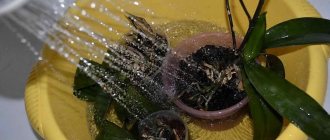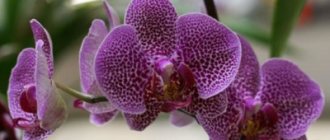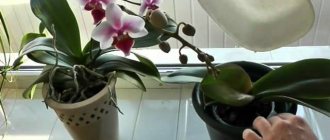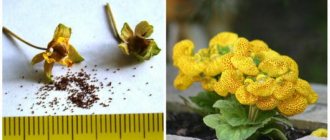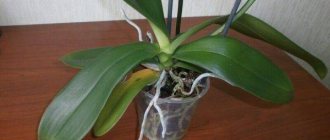Replanting an orchid differs from similar actions with other indoor flowers. This is because most representatives of the orchid family belong to epiphytes - “aerial” plants that in nature grow not in the ground, but on the trunk and branches of trees. They don't need land at all.
An adult orchid needs to be replanted at least once every 2-3 years.
Therefore, if you decide to transplant an orchid in the same way as the usual violet or geranium, then be prepared for unpleasant consequences. With an exotic flower you need to act differently. But as? Let's look at all the significant nuances of the process (with step-by-step photos!) using the example of the phalaenopsis orchid.
Lighting
During the first 7–10 days, the orchid should stand in a shaded place and under no circumstances be exposed to direct sunlight. The fact is that the absence of the sun imitates for this plant the native tropical (subtropical) rainy season, when the sky is covered with clouds, and the flowers “sleep” in a peculiar way, accumulating strength.
Then the orchid is returned to its usual place with diffused lighting and, if necessary, the lamp is turned on, bringing the daylight hours to 12 hours a day.
Why might problems arise and what kind?
Orchid owners may encounter flower disease, which is a common and unpleasant problem after replanting, and sometimes even the death of the plant.
At first, the roots may begin to hurt . They rot or dry out, and if treatment and correction of care are not started in time, then infection and fungus occur. You may see the leaves turn yellow and black or wet spots may appear on the leaves.
Also, if there is insufficient watering, for fear of overwatering the flower, drying out of the leaves and roots occurs, which is corrected by soaking the flower in water. This problem can occur with dry rot, which causes vascular wilt, which leads to the death of the orchid.
The plant withers
Reasons why leaves may begin to wilt:
- When the roots are mechanically damaged after transplantation.
- If they rot due to improper care of the flower.
- On the contrary, from drying out the roots of the plant.
- Lethargy is also possible due to an overdose of fertilizers.
- The soil is compacted too tightly during replanting, and the roots begin to suffocate.
- In winter, the plant may begin to wither due to heating from the battery or in summer from direct sunlight.
- Also, sagging leaves can occur due to pests.
What to do about it:
- if limp leaves appear after overheating, then remove the flower to a cool place, do not water or spray for a while;
- adjust the flower care regimen;
- if it dries out, it is necessary to restore the watering regime;
- if there are pests, you need to treat the orchid;
- when the roots are damaged, you need to remove the plant to a cool place for a couple of hours, and then place it in a bowl of warm boiled water for an hour, let it drain and return it to its original place.
The plant should recover gradually over several days. Attention! In case of severe damage to the root system, when the plant withers, it is necessary to remove it from the pot and trim the missing roots to healthy tissue, disinfect the remaining roots with cinnamon powder or activated carbon and replant them in a smaller pot.
The leaves are turning yellow
It must be remembered that every plant has periods when the leaves change color to yellow and dry out, thus the flower is renewed and this is a natural process. It is necessary to examine the orchid. If the old leaves located below turn yellow, then there is no reason to worry. You need to wait until the leaf dries and carefully pick it off.
But if yellowing occurs on young leaves, it can be assumed that the flower is sick. Most often the cause is improper watering. Let's take a closer look at the problems of yellowing leaves and how to get rid of them :
If the soil is overwatered, then with increased moisture, rot can settle, which does not allow the plant to live and feed normally. In order to get rid of yellowing and disease, you need to treat the plant.- If the orchid, on the contrary, is overdried, then the leaves will begin to wither from lack of moisture. To solve this problem, you need to start watering the flower in sufficient quantities and spraying the leaves.
- In the cold season, the problem of yellowing can arise due to freezing and drafts. You just need to adjust the temperature of the room and place the pot in a more suitable place.
- During the hot season, the foliage may be exposed to direct sunlight, which burns them. To combat this problem, you just need to remove the plant to a more suitable place.
Doesn't bloom
It often happens that an orchid does not want to bloom. The duration of flowering and frequency depend on the type of flower. Some species bloom only when there is stress in the form of temperature changes and lack of watering. Therefore, a gardener needs to know all the intricacies of caring for his pets. But if the plant has not bloomed after 6-12 months, then it is too early to worry, because a young peduncle can form even after 24 months.
If the plant does not bloom after transplantation, then the reasons for the lack of appearance of new flowers may be errors during the transplant. Transplantation is carried out when the plant has flowered . Usually, the yellowed and dry peduncle is removed, and the cut is treated with an antiseptic.
Also a likely cause may be a lack of light, and this often happens in winter, which can be corrected by creating additional illumination with artificial lighting.
How to deal with this?
The plant can be stressed. To set buds at home, you need a temperature of 10–12 degrees , as well as moderate watering. However, you should not do this suddenly. In this case, it is necessary to arrange the difference in day and night temperatures. Such care for about a month can lead to the formation of kidneys. But if this does not help, then bring the plant out of dormancy by gradually increasing the temperature and frequent watering.
For the successful growth of an orchid, it is important to know other nuances of replanting it: how to move it to another pot, what container and soil is needed, at what time of year and whether it is possible in the fall and during flowering, how to replant after purchase and if the arrow is released, how to preserve the roots.
Air temperature
In principle, the orchid is thermophilic - it needs stable temperatures of +24...28 °C all year round.
But for the first 7–10 days the air temperature is lowered to +20 °C. Elevated temperatures are contraindicated for an orchid during the adaptation period, as it can reduce the plant’s immunity. Then, over the course of several days, it is gradually increased to the usual level. That is, it is unacceptable to act abruptly, as with the return of lighting.
What do you need to consider when growing an orchid?
When buying orchids, many are alarmed by roots extending beyond the pot. It may seem that the flower is cramped in the pot. But that's not true. In natural conditions, the roots of orchids hang freely from the branches of the tree on which they live. The more roots a plant has, the more moisture it will take during fogs or rain. Therefore, roots that have “climbed” out of the pot are a sign of a healthy plant.
Phalaenopsis love to grow in transparent pots. The substrate for them is tree bark, not soil mixtures. Another unusual feature is that orchids do not tolerate being moved from one place to another. Even changing the angle of incidence of light is contraindicated. The plant will respond to changes in growing conditions by dropping buds. The main thing in growing phalaenopsis is stability. But sometimes an orchid needs to be replanted urgently, even if this leads to the buds falling off. An emergency measure may be needed in case of root rot or after purchasing a new plant in a store.
Watering
The orchid is watered once immediately after transplantation, then again after 4–5 days, and the third watering after 10–12 days. Then you can return to your usual routine, that is, watering 2-3 times a week.
The unique requirement of the flower for watering is that the pot is immersed in water to a third or half of its height, leaving the container to absorb water through the drainage holes for 20–30 minutes. Then the pot needs to be lifted, and all excess water will naturally drain out onto the tray.
4 popular orchid fertilizers for abundant flowering
Breeding rules
In cases where shoots, called babies, appear on various parts of the orchid, they can be planted. The process of planting children is no different from replanting an ordinary plant.
Nuances that should be taken into account when separating the baby from the mother flower:
- If the baby has formed in the leaf axil, then it needs to be cut off with a disinfected tool, capturing a couple of centimeters of tissue from the parent plant. The cut areas are treated with charcoal.
- The baby that has formed near the roots is also cut off with a treated tool, capturing the tissue of an adult flower. The cut sites are processed.
- The baby grown on the peduncle is cut off with a sterile instrument, capturing the tissue of the mother plant. The cut areas are sprinkled with coal.
Attention! You can only transplant a child that has at least three roots 3-5 cm long.
A basal baby may appear on the plant, growing directly from the peduncle of the mother plant. Such a shoot will not have its own roots, because it feeds from the root system of an adult flower. It will not be possible to separate the basal baby, as it will die immediately; it is recommended to leave the flower as is.
Air humidity
After transplantation, it should imitate the conditions of the “jungle”. You can place regularly moistened moss or expanded clay around the orchid pot. Additionally, the orchid should be sprayed daily on all leaves and stems with warm, soft water. The abundance of moisture in the above-ground part activates the vitality of the plant and also promotes its rooting in a new place. Whether it is necessary to moisturize the orchid in this way for longer than 2 weeks from the day of transplantation depends on the specific species and variety.
Timely feeding
A “relocated” orchid needs elements such as magnesium, potassium and nitrogen, and the latter substance must be kept to a minimum, otherwise the plant will begin to increase green mass in abnormal quantities. It is better to apply fertilizers simultaneously with watering, immersing the pot in a nutrient solution. This is done 2–3 weeks after transplantation.
In addition, 5–8 days after transplantation, the orchid can be “invigorated” with Zircon or Epin, which are universal anti-stress agents for any plants; they also help speed up flowering.
To summarize, we can say that caring for an orchid after transplantation really requires a serious approach and can largely determine the positive or painful further existence of the plant.
Is it possible to replant a diseased flower?
For a sick flower, transplantation in compliance with all technologies is the only chance for recovery. During the replanting process, all affected areas of the root and foliage systems are removed, soil that has become unusable is replaced, and proper treatment is carried out. To prevent flower disease, you can carry out preventive treatments with the following drugs:
- fungicides for fungal diseases;
- acaricides against ticks;
- insecticides for insects.
Orchids are not capricious flowers, and therefore, if you follow the basic rules of care and maintenance, they will grow and bloom without causing much trouble. Timely inspection of the root system and foliage will allow you to identify a plant disease in the early stages and take appropriate measures to eliminate it.
5/5 — (1 vote)
